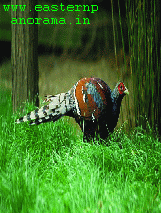Archives
Fowl Play The extinction of birds in Manipur
Interestingly for a common man, it is hard to find a live or dead Nong-in (Hume’s Bar pheasant). Interestingly, leaving alone the new generation, RK Birjit, an environmentalist who is a member of Bombay Natural History Society is yet to see a live a Nong-in bird in his 18 years of research activities on wild fowls and birds.
According to environmentalist Dr. Kh Shamungou, the people of Manipur had the belief that the eternal soul of an orphan unable to bear hunger and thirst had transformed itself into a bird to be known as Nong-in. In fact, this bird earned its name Nong-in because of its ability to predict changes in weather conditions (‘Nong’ meaning rain, ‘in’ means to follow). When sudden danger or a change of weather is sensed, Nong - ins crawl behind the rock-clefts with noisy calls. When a pair from a cleft-shelter starts calling, another pair nearby responds, and thus within a short period the air is filled with a chord of their calls. Trawlers take advantage of this in efforts to locate the bird.
The then Kings of Manipur used to present the feathers of this beautiful bird to the brave hunters and soldiers in recognition of their bravery and contribution to the kingdom. “This means that Nong-in has its habitats not only in the hills but also in the Manipur valley,” Birjit who teaches in a college in Manipur’s Bishnupur district says, “The bird has disappeared from our sight in the valley area due to certain factors - climate change in particular”.
 The State bird of Manipur Nong-in is greatly endangered. Besides the rare sightings they are facing the onslaught of hunters and man-made calamities. The forest cover of Manipur is 17,219 sq km which is 77.12 percent of the total geographical area of the state (22,327sq km), according to state forest report 2003. If an urgent step for this bird’s location and conservation is not taken up, the species is certain to disappear.
The State bird of Manipur Nong-in is greatly endangered. Besides the rare sightings they are facing the onslaught of hunters and man-made calamities. The forest cover of Manipur is 17,219 sq km which is 77.12 percent of the total geographical area of the state (22,327sq km), according to state forest report 2003. If an urgent step for this bird’s location and conservation is not taken up, the species is certain to disappear.
Nong-in, known as Hume’s Bar Pheasant after a British civil officer A O Hume named the bird after his wife during his stay in Manipur in 1883, is no longer found in the Manipur valley even though it is one of the seriously endangered bird species protected under the Schedule I of the Wild Life Protection (Act), 1972.
There is no sign of protecting this highly endangered state bird under this Act besides no one is serious in finding its present habitat.
However, the good news is that a team of energetic environmentalists are planning to conduct a Nong - in watching programme along the Manipur - Mizoram and Ukhrul and Chandel districts sector of Manipur - Myanmar international border soon.
Similarly, the decrease of the crow population in Manipur has led to the disappearance of Heikreng, an important tree which is used as a lighter during the funeral rites of the majority Meitei community since time immemorial. Heikreng seeds germinate very fast after they are softened inside the stomach of a crow.
“The state’s hill districts are no exception to the loss and drifting pattern of biodiversity. The Siberian migratory bird ‘Shiri’ has stopped visiting Shiroy peak in Manipur’s Ukhrul district during winter due to over-hunting and destruction of the habitats (Leihao trees) by timber merchants,” Dr RK Ranjan, an environment activist said.
Interestingly Koyal (Eudynamys Scolopacea), a warm climate bird, has started appearing in Manipur. “This shows that the climate and environment in Manipur has been changed to such an extent that Koyal can live comfortably here,” Dr Shamungou observed.
Loktak which once boasted of having a large variety of indigenous fish is now left with a scanty variety after the commissioning of the 90MW Loktak Hydro-power project in 1983. Next to rice, fish is a major part of Manipur’s food culture. It forms an important part of the traditional and religious rituals for the 2.5 million Manipuris.
However, environmental change, pollution and developmental activities ushered in by rapid modernization and urbanization as well as introduction of non-local fish species in pisciculture have shoved indigenous fish varieties to the brink of extinction.
Noted Environmentalist H Nandiram Sharma says, “Manipur’s hydrological system has been drastically changed due to human pressure and climate change.” In the early 20th century, the state had around 100 lakes. Now, except for Loktak, Pumlen and Sanapat, all of them have disappeared.
Director of State fisheries department K Saratkumar said, “Drying up of wetlands and farming of high yielding fish variety are also some factors for the death of local fish.”
According to Professor Dr W Vishwanath of Manipur University’s Life Sciences Department, 15 out of more than 200 fish species in the state are endangered. Among them are Nganap (Pangio pangia), Sareng Khoibi (botia berdmorei), Ngasep (mystus bleekeri) and Ngamu (Channa orientalis). “Warm water species are invading cold water areas due to global warming and climate change,” he said. “Thus some of species such as Ngatin, Ngawa, Ngara, Ngaroi, Sareng Khoibi (botia berdmorei) etc are moving towards the hill streams”. This is how the Ngakoi species has become available in the streams of Manipur’s Chingai sub-division under Ukhrul district,” he added.
Pengba (Osteobrama belangeri) which used to be found abundantly in the freshwater Loktak Lake and Nambul River is extinct in its wild habitat and now is cultured and bred only in ponds. Pengba was declared as state fish in November, 2007.

